If you’re looking for a spicy addition to your cooking, horseradish may be the herb for you! This herb is easy to grow and can be harvested fresh any time of year.
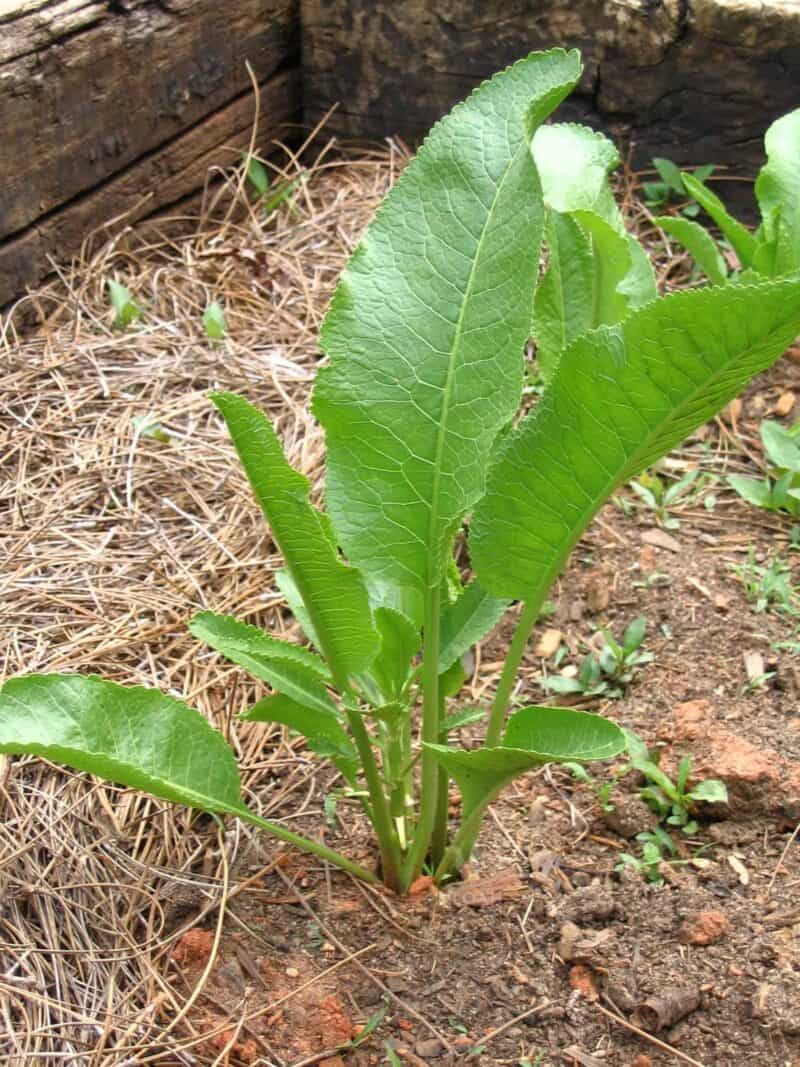
Horseradish is a rugged, cold-hardy perennial vegetable that grows exceptionally well in areas that experience harsh winters. This winter period forces the plants into dormancy and encourages more vigorous growth the following year.
Many people confuse horseradish with wasabi. To be fair, wasabi is often referred to as Japanese horseradish.
The two plants are actually closely related, hailing from the same family and possessing similar spicy flavors.
However, they are two distinct entities.
This clump-forming perennial can be categorized both as an herb and a vegetable. It has been cultivated for more than 3,000 years.
It’s typically grown for its spicy yellow to white roots that can add flavor to all kinds of different dishes. It also has shiny dark green leaves that add ornamental appeal to the garden.
Typically planted in the spring, it grows rapidly, with the roots ready for harvest by fall. It grows up to two or three feet tall and wide and is hardy in USDA zones 4-8.
Table of Contents:
Best Types of Horseradish to Grow
There are a few types of horseradish you can grow. This includes common horseradish, which has broad and crinkled leaves. There’s also Bohemian horseradish, a variety that has narrow and smooth leaves.
As you might expect, common horseradish is the easiest kind of horseradish to find.
You might also be able to find a type of horseradish known as ‘Variegata.’ This variety is less invasive than the traditional option and is also more shade-tolerant. It has beautiful marbled leaves, too, meaning it can add even more ornamental value to your garden.
Planting Horseradish
Horseradish is planted from small root pieces, also known as sets. It’s so easy to establish that you can often cut up an existing plant and use those cuttings to start new plants in your garden.
You can plant these sets in your garden in the early spring, as soon as the soil has thawed. It is important to plant as early as possible, since the plants need a long season to develop strong roots.
Your plants should be grown in an area where they can get at least six hours of sunlight each day. The soil should be rich in organic matter and have a slightly acidic to neutral pH.
The best spot to plant horseradish in your garden will be one that receives full sun and has loose-well draining soil. Clear the site of weeds and rocks before you plant. You may also want to amend the soil with a bit of compost before you plant as well.
When you plant, note that horseradish can easily crowd out nearby plants. It is highly invasive, which is why some people choose to grow it in containers. This can help to limit its spread.
To plant your horseradish sets, do so at a 45-degree angle with the sets about three inches deep. They should be spaced 18 inches apart. Water deeply after planting.
Growing Horseradish From Seed
You can also grow horseradish from seed, though this isn’t as common. You can start seeds indoors in January or February and transplant outside in April.
Plant seeds about ¼ to ½” deep in moist soil, ideally in peat pots that you can transplant directly into the ground. The seeds should germinate in one to two weeks and you can put these in the garden just as you would regular sets.
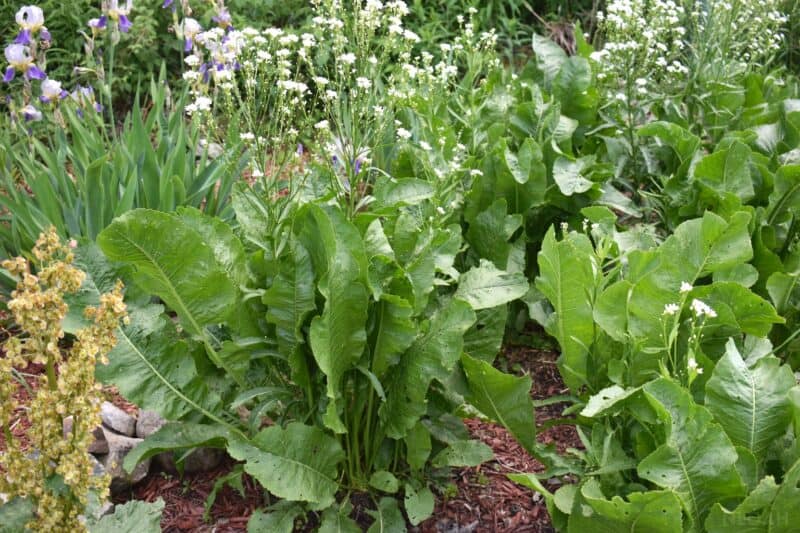
Caring For Horseradish Plants
Horseradish plants are incredibly tough and hardy – once you get them in the ground, there is very little that you will need to do to care for them. Here are some general tips.
Watering Horseradish
Horseradish plants have very moderate water needs. Too little can cause the roots of your plants to develop a woody texture with a poor flavor, while too much can soften the roots and cause them to develop a strong flavor.
Shoot for a “sweet spot” of around one to two inches of water each week.
Keep your plants as cool as possible. These cold-loving plants grow best in temperatures ranging from about 45 to 75 degrees Fahrenheit. Humidity isn’t much of a concern as long as there is enough moisture in the soil.
Fertilizing Horseradish Plants
It is very rare that you will need to fertilize your horseradish plants. You can add some compost or other organic matter (or even a conventional 10-10-10) to the soil when you first plant, but otherwise, you should only need to fertilize when your plants are showing signs of deficiencies, like yellowing leaves.
If that’s the case, you should only need to apply fertilizer about once every four weeks.
Wedding Horseradish
Once your plants become established, you’ll likely find that you don’t need to weed around them very often. That’s because they outcompete other plants with ease.
However, as the young seedlings are first starting to grow, weed often and carefully, so you don’t damage the roots.
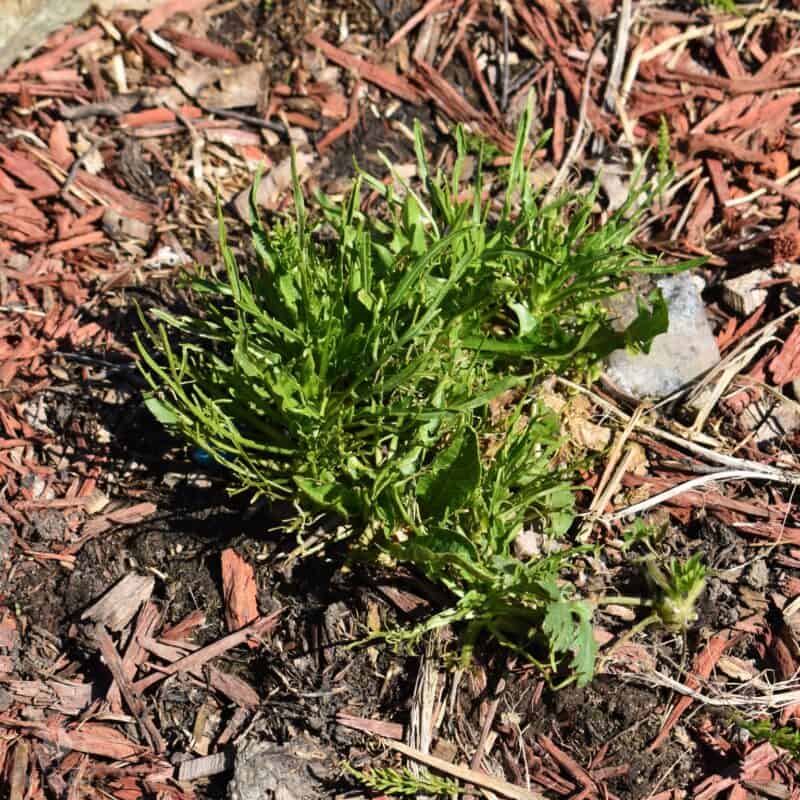
Pruning
As your horseradish plants grow, they’ll send out multiple shoots. Each one will produce its own small shoots in turn and take more energy away from your plant. This can diminish its overall growth.
Therefore, it’s a good idea to prune these roots on a regular basis. Remove all but one or two shoots when you prune so that the remaining ones can grow larger.
This process is also referred to as “stripping” the roots. It will provide you with the best quality horseradish and allow you to get rid of unhealthy leaves and sprouts.
Propagating Horseradish
If you prune your horseradish plants as described above, you can use the cuttings to propagate new plants. This is a great way to use up cuttings that you don’t plan on eating.
When digging up the roots, select side roots that are at least eight inches long. Cut these across the top in a straight, forward motion, then angle them at the bottom. That way, you’ll know which end has to go on the bottom.
Clean the cuttings, then let them dry. Store them in moist sand and make sure they aren’t exposed to light, then replant in the spring as soon as the soil is workable.
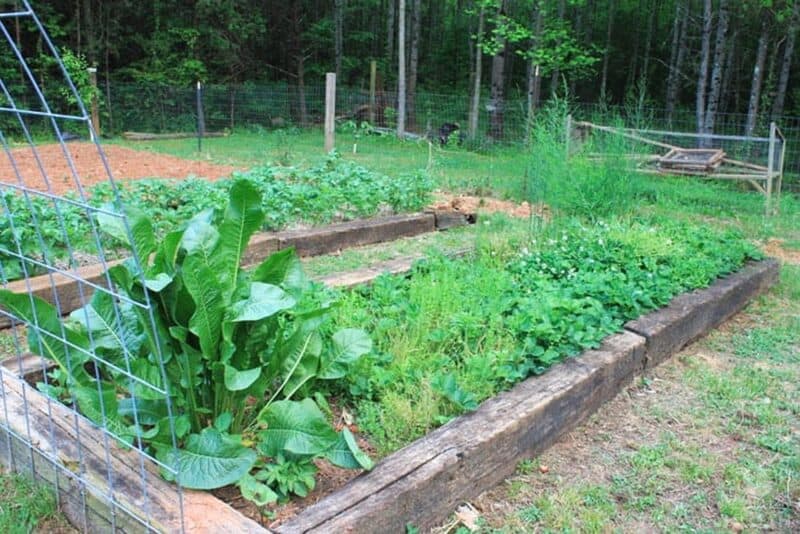
Growing Horseradish in Containers
You can even grow horseradish in containers – a smart option if you’re concerned about your plants overtaking your garden.
To do this, you’ll need a relatively large container, ideally one with a depth of at least 30 inches so the roots have space to grow. Make sure the container has adequate drainage holes, too, so that your plants do not become waterlogged.
The best kind of material for a horseradish container is unglazed clay, since this will allow the excess moisture to escape through the walls. Plant your roots just as you would if you were planting them in the ground and care for them in the same way.
Water only when the top inch or two of soil is dry – and fertilize on a monthly basis, since containers tend to leach both nutrients and water a lot faster than plants grown in the ground.
Repotting
If you’re growing horseradish in containers, you may find that they occasionally outgrow their containers. You can repot the plant into larger containers but it’s often easier just to start with an oversized container at the beginning to give the plants room to expand.
Overwintering Your Plants
Horseradish plants don’t need any special steps for overwintering. Simply leave them in the ground and consider covering them with a layer of mulch if you want to add additional protection from the cold in extremely harsh climates.
Your plants should come back each spring, with the roots growing additional plants nearby.
Pests and Diseases
There are very few pests that affect horseradish plants, in part due to their strong and pungent aroma. However, you’ll want to keep an eye out for common garden pests like flea beetles and aphids.
To prevent these pests, plant your horseradish away from other plants in the Brassicaceae family, as these can attract similar types of pests.
On that note, diseases are also extraordinarily rare. In overly wet, soggy conditions, you may have issues with root rot. Proper drainage is key to preventing this disease, as there is really not much of a cure to speak of.
Harvest your plants often in the fall. This can help to prevent the spread of diseases that may have overwintered in the soil.
Harvesting Horseradish
If you plant your horseradish in the spring, the roots should be ready for harvest in October or November.
If your schedule permits, wait until after the first or second frost to harvest. This will improve the flavor of the plants but still allow you to harvest thyme before the ground freezes solid.
Harvesting your roots can sometimes be tricky because the roots are delicate and difficult to remove.
To get them out of the ground, dig around the base of the plant and lift the large central root out, as well as all the smaller roots you can reach.
Once the roots are out of the ground cut the foliage, leaving just an inch on the roots, and scrub the remaining dirt off.
Allow the roots to dry thoroughly. You can keep them in your refrigerator for about one month, wrapping them in plastic wrap to prevent them from drying out.
If you don’t have enough space in your refrigerator for all other roots, they can be stored in a dark root cellar covered in damp sawdust or sand. Just make sure they’re placed in a location where they will not freeze.
When you harvest horseradish, save any that are eight inches or longer. You can use these for next year’s planting stock.
In some cases, you may also be able to harvest horseradish in the spring.
In fact, this is a common source of contention among gardeners – some argue that the finest flavor comes from horseradish harvest in the spring, while others claim that fall-harvest horseradish is the best.
Feel free to harvest at both times – this plant grows so prolifically, you shouldn’t run out or have to worry about damaging the plant in any way with multiple harvests!
Using Horseradish
There are countless ways you can use horseradish in your cooking!
One of the best ways is to process it for use as a condiment. To do this, wash the roots well and then peel them. Cut them into small, half-inch slices and puree them up in a food processor or blender. Add a ¼ cup of water and crushed ice to this.
If you want your horseradish puree to be on the spicy side, add a few tablespoons of white wine or rice vinegar along with half a teaspoon of salt, but wait to do this until about a minutes after pureeing. For a milder condiment, add vinegar and salt right after pureeing instead of waiting.
You may find that your horseradish is a bit too runny – if that’s the case, strain it through a sieve to get the excess liquid out. You can store it for up to six weeks in the refrigerator.
Some people just prefer to shave, grate, or slice horseradish to put on dishes. That’s fine, too – and again, the horseradish should last several weeks when stored properly in the refrigerator.
Grow Horseradish This Year
Horseradish is a delicious and easy-to-grow root vegetable. If you’re looking for an interesting addition to your garden that offers tasty roots along with attractive foliage, horseradish may be the perfect plant for you.
Be sure to review our horseradish growing tips as you get started with this plant in your garden – and give it plenty of space to sprawl and spread out!
With a little bit of effort, you can have a bountiful harvest of this spicy root vegetable, which you can even preserve (by freezing, for example) to have it year-round.
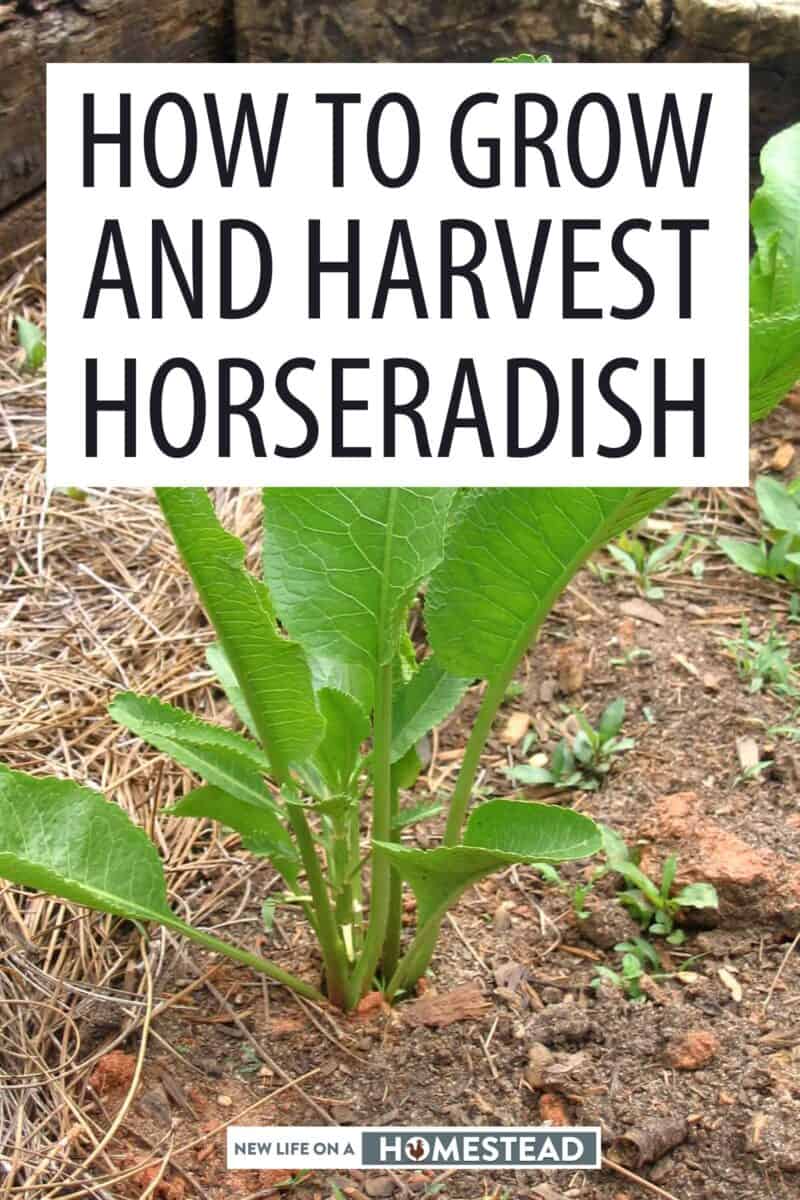

Rebekah is a high-school English teacher n New York, where she lives on a 22 acre homestead. She raises and grows chickens, bees, and veggies such as zucchini (among other things).

Wedding horseradish – my favorite!